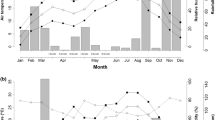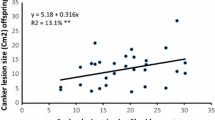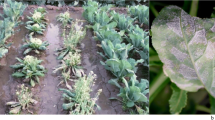Abstract
Powdery mildew disease caused by Erysiphe (sect. Microsphaera) pulchra a (Cook & Peck, Braun & Takamatsu) is a devastating disease in flowering dogwoods (Cornus Florida) throughout southeastern USA where flowering dogwood is widely grown. Host resistance is the most sustainable and economical way for controlling this disease, but resistance breeding has been slow and genetic information on powdery mildew resistance is unavailable. In this study, pseudo F2 populations derived from crosses between selected resistant (R) and susceptible (S) plants (RxR, RxS and SxR), were evaluated for disease severity at two locations in three years, McMinnville in 2005 and 2012, and McMinnville and Nashville, TN, in 2013. Disease reaction in progeny from reciprocal crosses was similar indicating that there was no cytoplasmic inheritance of resistance genes. Disease severity of progenies showed continuous distributions, suggesting that powdery mildew resistance is inherited quantitatively. High narrow sense heritability (0.74 in 2005, 0.84 in 2012 and 0.90 in 2013) and broad sense heritability (0.9) in parental clones were observed. This information will be useful in breeding programs for dogwood improvement.



Similar content being viewed by others
References
Allard, R. W. (1999). Principles of plant breeding. New York: Wiley.
Aravanopoulos, F. A. (2010). Contribution of leaf morphometricsin the study of genetic entries in Salix L. In (1st Ed) Electronic Journal of Plant Breeding, 1320–1328.
Aust, H., & Hoyningen-Huene, J. V. (1986). Microclimate in relation to epidemics of powdery mildew. Annual Review of Phytopathology, 24(1), 491–510.
Banerjee, R., Das, N. K., Doss, S. G., Saha, A. K., Bajpai, A. K., & Bindroo, B. B. (2012). Narrow sense heritability estimates of bacterial leaf spot resistance in pseudo F2 (F1) population of mulberry (Morus spp.). European Journal of Plant Pathology. doi:10.1007/s10658-011-9894-z.
Leu, B.-H. (1997). Statistical genomics linkage, mapping and QTL analysis (pp. 59–60). LLC: Introduction to genomics. CRC press.
Bokmeyer, J. M., Bonos, S. A., & Meyer, W. A. (2009). Inheritance characteristics of brown patch resistance in tall fescue. Crop Science, 49, 2302–2308.
Bonos, S. A. (2006). Heritability of dollar spot resistance in creeping bentgrass. Phytopathology, 96(8), 808–812.
Bonos, S. A., Kubik, C., Clarke, B. B., & Meyer, W. A. (2004). Breeding perennial ryegrass for resistance to gray leaf spot. Crop Science, 44(2), 575–580.
Bovi, M. L. A., Deresende, N. D. V., Saes, L. A., & Uzzo, R. P. (2004). Genetic analysis for sooty mold resistance and heart of palm yield in Archontophoenix. Science Agriculture (Piracicaba, Braz.), 61, 178–184.
Braun, U., & Takamatsu, S. (2000). Phylogeny of erysiphe, microsphaera, uncinula (erysipheae) and cystotheca, podosphaera, sphaerotheca (cystotheceae) inferred from rDNA ITS sequences-some taxonomic consequences. Schlechtendalia, 4, 1–33.
Chouard, P. (1960). Vernalization and its relations to dormancy. Annual Review of Plant Physiology, 11, 191–238.
Fehr, W. R. (1987). Theory and technique. In In Vol 1 principles of cultivar development. New York: Macmillan Publishing Co.
Guimaraes, L. M. S., Resende, M. D. V., Lau, D., Rosse, L. N., Alves, A. A., & Alfenas, A. C. (2010). Genetic control of eucalyptus urophylla and E. grandis resistance to canker caused by chrysoporthe cubensis. Genetics and Molecular Biology, 33, 525–531.
Han, Y., Bonos, S. A., Clarke, B. B., & Meyer, W. A. (2006). Inheritance of resistance to gray leaf spot disease in perennial ryegrass. Crop Science, 46(3), 1143–1148.
Nurseries, H., Hiller, A., & Coombes, J. J. (2007). Hillier’s manual of trees and shrubs. Newton Abbot, United Kingdom: Davis and Charles.
Horsfall, J. G., & Barrat, R. W. (1945). An improved grading system for measuring plant diseases. (abstract.). Phytopathology, 35, 655.
Jorge, V., & Verdier, V. (2002). Qualitative and quantitative evaluation of cassava bacterial blight resistance in F1progeny of a cross between elite cassava clones. Euphytica, 123, 41–48.
Klein, J. I. (1998). A plan for advanced-generation breeding of jack pine. Forest Genetics, 5, 73–83.
Leigh, A. K., Windham, M. T., & Trigiano, R. N. (1998). Natural occurrence of microsphaera pulchra and phyllactinia guttata on two cornus species. Plant Disease, 82, 383–385.
Li, Y., Mmbaga, M. T., Windham, A. S., Windham, M. T., & Trigiano, R. N. (2009). Powdery mildew of dogwoods: current status and future prospects. Plant Disease, 93, 1084–1092.
Li, Y., Windham, M. T., & Trigiano, R. N. (2005). Spore germination, infection structure formation, and colony development of erysiphe pulchra on dogwood leaves and glass slides. Plant Disease, 89, 1301–1304.
Majidi, M., Mirlohi, A., & Amini, F. (2009). Genetic variation, heritability and correlations of agro-morphological traits in tall fescue (Festuca arundinacea schreb.). Euphytica, 167(3), 323–331.
Mmbaga, M. T. (2002). Ascocarp formation and survival and primary inoculum production in erysiphe (sect. Microsphaera) pulchra in dogwood powdery mildew. Annals of Applied Biology, 141(2), 153–161.
Mmbaga, M. T., & Sauve, R. J. (2004). Multiple disease resistance in dogwoods (cornus spp.) to foliar pathogens. Journal of Arboriculture, 30(2), 101–107.
Nyquist, W. E., & Baker, R. J. (1991). Estimation of heritability and prediction of selection response in plant populations. Critical Reviews in Plant Sciences, 10(3), 235–322.
Owolade, O. F. (2006). Line x tester analysis for resistance tocassava anthracnose disease. World Journal of AgriculturalSciences, 2, 109–114.
Reed, S. M. (1999). Development of a labor-efficient hand pollination procedure for flowering dogwood. Journal of Environmental Horticulture, 17(2), 92–94.
SAS Institute. (2002-2010). SAS/STAT user’s guide, Version 9.3 Cary, NC.
Scott, J., & Jones, J. (1989). Inheritance of resistance to foliar bacterial spot of tomato incited by Xanthomonas campestris pv. Vesicatoria. Journal of the American Society for Horticultural Science, 114(1), 111–114.
Stommel, J. R., & Griesbach, R. J. (2008). Inheritance of fruit, foliar, and plant habit attributes in capsicum. Journal of the American Society for Horticultural Science, 133(3), 396–407.
U.S. Department of agriculture. (1998). Census of horticultural specialties, USDA, Natl.Agr. Stat. Serv., Wash., D.C.
US Department of Agriculture. (2009). 2007 census of agriculture, Washington DC.
Wadl, P., Skinner, J., Reed, S., Rinehart, T., Pantalone, V., & Trigiano, R. (2009). Honeybee-mediated controlled pollinations in cornus Florida and C. kousa intra- and interspecific crosses. Hortscience, 44(6), 1527–1533.
Windham, M. T., & Witte, W. T. (1998). Naturally occurring resistance to powdery mildew in seedlings of cornus Florida. Journal of Environmental Horticulture, 16, 173–175.
Windham, M. T., Trigiano, R. N., & Windham, A. S. (2005). Susceptibility of cornus species to two genera of powdery mildew. Journal of Environmental Horticulture, 23(4), 190–192.
Xu, P., Wu, X., Wang, B., Hu, T., Lu, Z., Liu, Y., & Li, G. (2013). QTL mapping and epistatic interaction analysis in asparagus bean for several characterized and novel horticulturally important traits. BMC Genetics, 14(1), 4.
Acknowledgments
The Authors gratefully acknowledge Dr. Lucas Mackasmiel, Terri Simmons and Terry Kirby with their technical support and field assistance throughout the project. In addition, we wish to thank, Dr. Matthew Blair and Dr. Tim Rinehart for their valuable suggestions. Research was partly supported by USDA-NIFA.
Author information
Authors and Affiliations
Corresponding author
Rights and permissions
About this article
Cite this article
Parikh, L., Mmbaga, M.T., Kodati, S. et al. Estimation of narrow sense heritability of powdery mildew resistance in pseudo F2 (F1) population of flowering dogwoods (cornus Florida L). Eur J Plant Pathol 145, 17–25 (2016). https://doi.org/10.1007/s10658-015-0806-5
Accepted:
Published:
Issue Date:
DOI: https://doi.org/10.1007/s10658-015-0806-5




